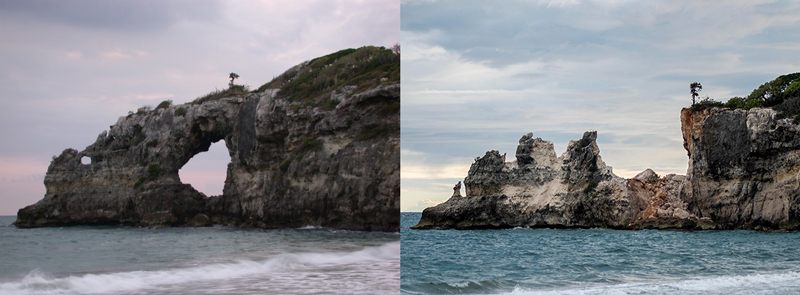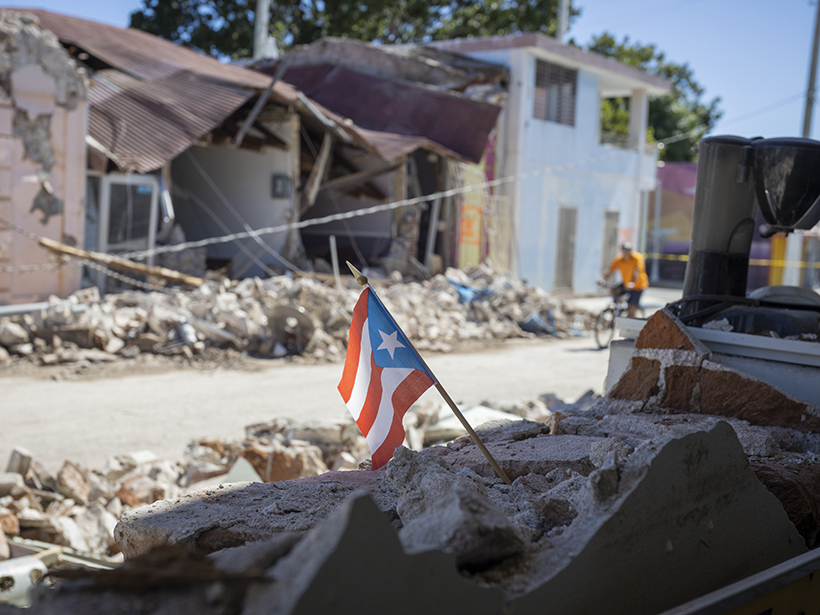A translation of this article was made possible by a partnership with Planeteando. Una traducción de este artículo fue posible gracias a una asociación con Planeteando.
More than 500 earthquakes larger than M2.0 have shaken Puerto Rico since 28 December 2019. The strongest events so far, including an M5.8 followed by an M6.4, occurred within a 24-hour window this week. Puerto Rico declared a state of emergency following these events.
The quakes damaged structures in the southwestern region of the island, including homes, schools, municipal buildings, roads, and bridges. There remain widespread power outages, and around 300,000 homes are without water. The M5.8 event collapsed the Punta Ventana, a natural rock archway and popular tourist location in Guayanilla. As of 7 January, there have been multiple injuries and at least one fatality in the nearby city of Ponce.

There is a roughly 6% chance that an earthquake will be followed by a larger quake instead of a smaller one. The most common earthquake sequence, called main shock–aftershock, comprises one large earthquake followed by smaller quakes of diminishing intensity.
In Puerto Rico, however, “what we’re looking at here are earthquakes of more or less common size: There’s still lots of small ones but quite a few fives and then up to the 6.4,” said Jackie Caplan-Auerbach, a seismologist at Western Washington University in Bellingham. “That is a little more like what we would call an earthquake swarm, where there isn’t a clear dominant one early in the sequence and then a tapering.”
“Having this many large earthquakes is not necessarily a common thing, but it’s certainly not unheard of,” Caplan-Auerbach said.
Strongest, Biggest Swarm in Decades
The plates of Earth’s lithosphere are constantly pressing on each other in a battle of stress versus friction. Any slip or readjustment can cause an earthquake.
The region around Puerto Rico “is a very complex area,” explained Cindy Mora-Stock, a seismologist at Western University in London, Ont., Canada. “It involves the Puerto Rico–Virgin Islands microplate in a complex rotational dance between the North American plate on the north and the Caribbean plate on the south.” The North American plate moves about 20 millimeters per year relative to the Caribbean plate. “This creates regions of compression and extension, which generate the subductions north and south of Puerto Rico island, as well as a strike-slip fault in the middle.”
“The most recent time that we ever had such destruction in Puerto Rico from earthquakes was in 1918.”
“The Puerto Rico region is characterized by sequences of seismic activity, and a lot of [that activity is] located especially in the southwestern part of Puerto Rico,” said seismologist Christa von Hillebrandt-Andrade. “So periodically we will see earthquake swarms or earthquake sequences with dozens or up to hundreds of events.”
Von Hillebrandt-Andrade manages the National Weather Service’s Caribbean Tsunami Warning Program (CTWP) in Mayagüez, Puerto Rico. The CTWP works with the Puerto Rico Seismic Network, which has been monitoring the ongoing events, to evaluate the tsunami risk associated with seismic activity. The recent earthquakes have not presented a significant tsunami risk to the region.
The U.S. Geological Survey (USGS) reported that the M5.8 earthquake on 6 January and the M6.4 earthquake on 7 January were the result of oblique strike-slip faulting at a depth of about 10 kilometers. The quakes took place offshore south of the island.
“Since we’ve had our seismic network [beginning in 1974], we’ve never had this size of earthquakes or the amount of earthquakes of such a high intensity and magnitude in the region,” von Hillebrandt-Andrade added. “The most recent time that we ever had such destruction in Puerto Rico from earthquakes was in 1918.”
Swarms, Like Quakes, Are Unpredictable
Despite being what seismologists would call moderate-sized events, quakes greater than magnitude 6.0 can cause significant damage. “An M6.4, as we are seeing, can be really significantly damaging,” Caplan-Auerbach said. “It in itself is not an enormous earthquake. Damage in a 6.4 is commonly related to other issues [such as] the building construction, what the subsurface geology is like, and of course proximity.”
Moreover, “this is a really shallow earthquake. And so because of that, that tends to make the shaking significantly more impressive [and] have greater impact,” she said.

The USGS aftershock forecast predicts as many as 160 small aftershocks of at least M3.0 in the next week and a 7% chance that Puerto Rico will experience another earthquake larger than M6.4. The aftershock forecasts are still a work in progress, von Hillebrandt-Andrade cautioned, and residents could yet experience even larger quakes.
Mora-Stock likewise advised that residents should remain on alert. “Swarms are unpredictable, as earthquakes are,” she said. “Sometimes they precede big main shocks, and more times than others they just finish as they started.”
—Kimberly M. S. Cartier (@AstroKimCartier), Staff Writer
Citation:
Cartier, K. M. S. (2020), Rare earthquake swarm strikes Puerto Rico, Eos, 101, https://doi.org/10.1029/2020EO138432. Published on 09 January 2020.
Text © 2020. AGU. CC BY-NC-ND 3.0
Except where otherwise noted, images are subject to copyright. Any reuse without express permission from the copyright owner is prohibited.

